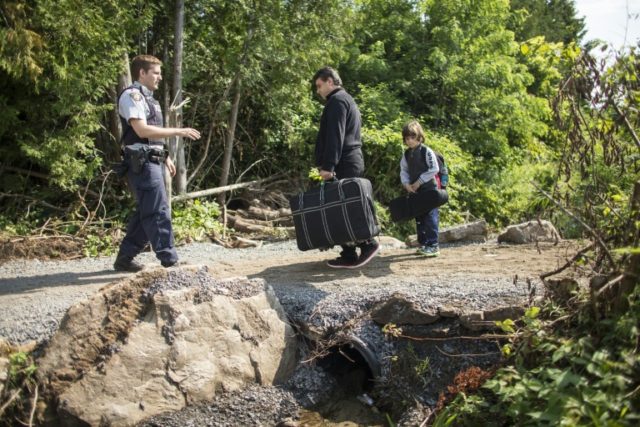Ottawa (AFP) – The number of asylum seekers from the United States crossing forests and farmers’ fields on foot to reach Canada jumped at the beginning of this year, and authorities are bracing for more.
The surge in walk-in arrivals started in 2016 with the election of US President Donald Trump, who has sought to crack down on legal and undocumented immigration.
Nearly 21,000 border jumpers were intercepted by the Royal Canadian Mounted Police (RCMP) in 2017 and allowed to file a refugee claim, officials told reporters on Friday.
Another 6,373 made their way into Quebec, Manitoba and British Columbia provinces from January to mid-April this year, which was more than double the number of arrivals during the same period last year.
“There’s a likelihood that we will see even more people” as this year’s particularly stormy and cold winter cedes to warming spring temperatures, said a senior border security official.
“We have right now roughly 75 to 80 people a day crossing (into Quebec). A few weeks ago that might have been as low as 50 a day.”
Most of the recent arrivals had travelled to the United States from Nigeria before coming to Canada. Others originated mostly from Colombia, Pakistan and Haiti.
The Caribbean nation of Haiti, along with countries in Africa, was among those which Trump in January reportedly labelled “shithole countries” and questioned why the US should accept their immigrants.
While Quebec has seen an uptick in arrivals so far this year, the prairie province of Manitoba and westernmost British Columbia welcomed fewer irregular migrants — a term used for asylum seekers who do not arrive by way of an airport or border checkpoint.
Although the surge in walk-in arrivals to Canada began with Trump’s election later it spread to include migrants who appeared to have intended from the start to come to Canada after flying to the United States on a visitor visa.
The federal government set up a task force to try to deal with the influx, which has at times overwhelmed government services.
Several senior Canadian ministers travelled to the United States to speak to the various diasporas to try to discourage border jumpers.
They warned that landing in Canada is “not an automatic ticket to being accepted here.”
Preliminary figures showed that more than 90 percent of claims by Haitian nationals and more than half of those filed by Pakistani and Nigerians were rejected.
The majority of claims made by Syrian, Eritrean, Yemeni, Sudanese, Djiboutian and Turkish nationals who arrived via the United States were accepted.
On average, Canada welcomes 300,000 immigrants and refugees each year.

COMMENTS
Please let us know if you're having issues with commenting.